How To Keep Dogs Out Of Your Garden
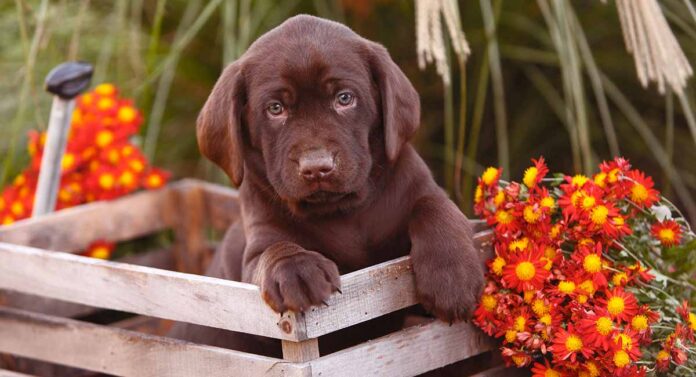
The main methods to keep dogs out of garden areas are training and dog repellents. These come in natural and artificial forms. Studies show mixed results on the effectiveness of dog repellents. But, you can also alter your garden design and use dog barriers to keep dogs out of garden areas they shouldn't be in!
There is joy to be had in a lovely garden, just as there is joy to be had in sharing your life with a dog. Sometimes attempting both can be challenging, but it can be done. Let's take a closer look at how.
There are various methods you can use to keep dogs out of garden areas, and we'll look at each in some detail.
Why Keep Dogs out of Garden?
There is nothing puppies enjoy more than a bit of 'freestyle' gardening. Most young Labradors think that a rose bush looks a lot better when it has been uprooted and dragged around the garden a few times. And of course, digging up your prize carrots is always a good way for any Labrador puppy to start the day. In fact, digging of any kind is a source of joy to many dogs, not just puppies. This can come as quite a shock to a first-time Labrador owner.
Why you Might Need a Dog Deterrent
If it is your dog causing the problem, you might think that you shouldn't need dog deterrents or barriers. Surely by six or seven months old you should be able to leave your puppy unsupervised for a few minutes, without him destroying your shrubbery? Shouldn't you? After all, not all puppies dig up the yard as soon as Mom or Dad turn their backs. Your neighbor's puppy probably has no enthusiasm for landscape gardening at all.
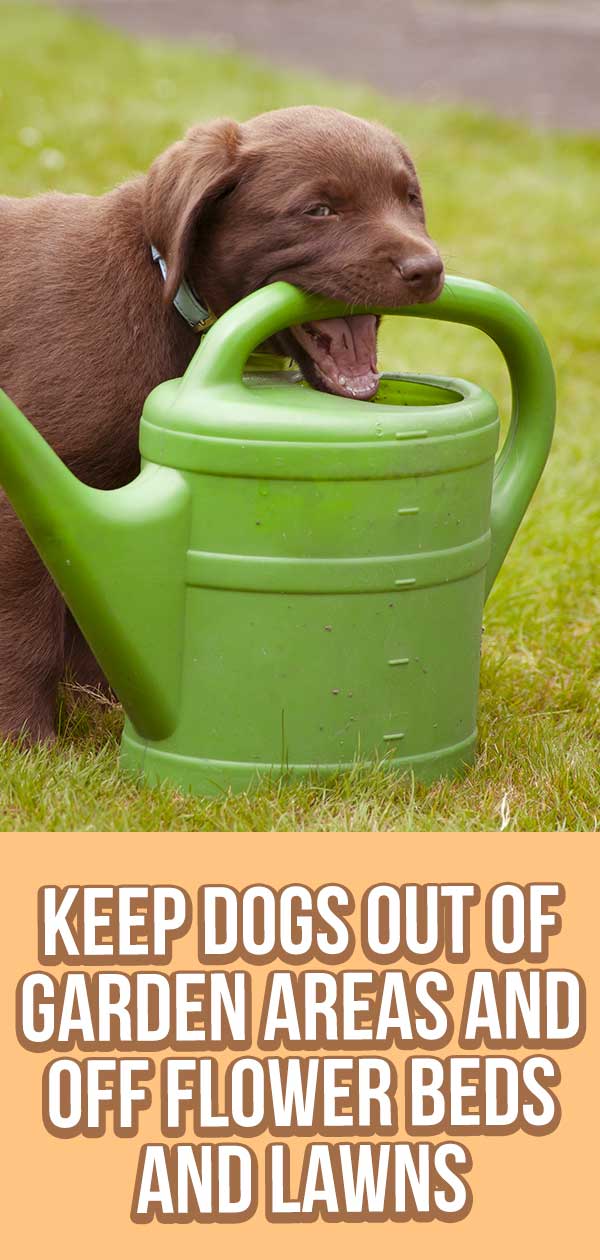
Are All Dogs Destructive in Gardens?
Some puppies are positively angelic outdoors. Which makes the owners of the naughty ones feel as though they are doing something wrong. I can reassure you that for the most part they are not doing anything wrong at all. Destructive behavior in puppies left unsupervised outdoors is so common as to be considered normal.
In the photo above, you will find my own puppy, Rachael, relaxing in the mess she has made on our patio, after being left to her own devices for rather too long. Your dog's excavating abilities may rival those of a backhoe, but they don't indicate an unstable temperament or some kind of mental disability. You simply have a normal Labrador puppy.
Ways to Keep Dogs out of Garden
So, your dog is normal. That's the good news. But it doesn't change the fact that you don't want a dog, any dog, digging in your flower beds or rooting around in your vegetable patch. Naturally, as the owner of a young tearaway, you are looking for a quick and effective dog deterrent solution. A command or training method that will keep dogs out of garden areas, off flowerbeds and put a stop to the destruction and naughtiness.
Most importantly, you want to be able to let the dog into the yard without watching him like a hawk every second he is out there. We'll examine the main ways to keep dogs out of gardens and prevent your little piece of paradise turning into a moonscape.
Your Options
Here are some of the options we are going to consider:
-
- Altering your garden design
- Training your dog
- Dog proof barriers
- Dog repellent and deterrent methods
- Wait it out.
Let's start with a look at changes you can make to your yard/garden to make it more compatible for life with a dog.
Altering Garden Design
The first option we'll consider is making changes to the design and style of your yard to keep dogs out of garden.
One of the problems with dogs is knowing which areas are off-limits to them. This is much more difficult if the boundaries are blurred or not physically obvious. The point where grass ends and flowers begin might be clear to you, but it isn't clear to a puppy. Raised flower beds with a solid boundary help dogs make these distinctions. Putting plants in heavy raised tubs can reduce digging, so can replacing grass with paving or pebbles. You can get great ideas for designing gardens that are home to dogs on Pinterest.
Redesigning your garden can be a great solution if you can't keep dogs out of garden areas you own, or you don't want to.
Plants to Keep Dogs out of your Garden
Another option is to plant things that will naturally repel your dog. These are generally plants with odors that dogs dislike. They are not harmful to dogs, but dogs will naturally avoid them. Using dog repellent plants for borders will help keep dogs out of gardens or certain areas of your yard. This technique will effectively set a boundary that your dog is likely to respect.
Dog repellent plants include common rue, chili peppers, citrus trees, lemongrass (citronella), garlic and onion. Of course, not all of these grow in every climate zone or are suitable for every garden. Common rue repels dogs, cats and ants; however, it is harmful if ingested by humans. Use caution if children will play where it's planted.
Another type of plants to keep dogs out of your garden are prickly plants. These can be used for edging and include varieties such as aloe, agave, hollies, barberries or huckleberry. The prickly feel of these plants may deter some dogs from stepping on flower beds or entering an area they border.
Changes in garden design aren't for everyone, so what about training? Can you teach a dog not to go on your flowerbeds?
Training Your Dog
Training is certainly an option. Dogs can be trained to remain in one particular part of a garden while avoiding others. But it isn't as simple as teaching a dog to sit, and it requires your active participation until they are fully trained. If you plan to undertake this kind of training, you will need to monitor your dog continuously while he is outdoors for some time to come, and to spend several minutes a day, two or three times a day, on training sessions.
Here's a Kikopup video that will give you an idea of what's involved.
This is useful training. But it's also training that is best suited to those who are normally out with their dog in the yard or garden. If you ultimately wish to leave your dog outdoors completely unsupervised, relying on a trained behavior is not something that even I, as a relatively experienced trainer, would consider doing. For the unsupervised dog, the best remaining option to keep dogs out of garden areas is likely to be dog proof barriers and/or a dog repellent.
Barriers and Dog Repellents
We mentioned raised flower beds earlier to keep dogs out of garden areas. These may deter dogs from straying onto your plants, and they can help you train your young dog to respect the flowers when you are in the garden together, but they are not dog proof. Raised beds are not going to stop a determined digger from mounting an attack on your roses. So, how do you keep dogs out of garden areas?
I've seen mulching with rose pruning suggested, but I would worry about dogs getting thorns in their pads. A better alternative is pinecones, especially if those are abundant in your area. Protecting your plants with permanent barriers is likely to be an unappealing option to keep dogs out of garden areas. Both because it is hard to build attractive barriers around flower beds that are actually dog proof and because it is a lot of work.
Think of Your Dog's Age
With a puppy, you may decide a better option is to compromise with temporary fencing – wire netting for example – around your flowers and accept that your yard isn't going to win any competitions this year.
If it's an older dog causing problems, a simpler option might be to fence off part of your yard specifically for the dog to play in. Create an exercise yard or dog playground of some kind. These can be quite attractive and again, Pinterest is a good place for inspiration.
If none of those appeals to you, that leaves us with dog repellents. Let's find out what a dog repellent is, whether dog repellents or dog deterrents work, how safe they are, and where you can find them.
Dog Repellents
A dog repellent is something that a dog finds unpleasant and will choose to avoid. We are not looking at hand-operated training devices here, but rather at repellents that you can set up and leave. The idea is that the repeller sits in the area that you wish your dog to steer clear of and it works in your absence.
To act as a deterrent, the device must create an environmental trigger that a dog dislikes and may find upsetting. This is not something to undertake lightly or with a nervous dog or one that lacks confidence outdoors. Dog repellents for gardens fall into three categories:
- Ultrasonic – dog repellents that use sound
- Dog repellents that use water
- Chemical or odor dog repellents.
Let's take a look at ultrasonic animal repellers first.
Dog Repellent Sounds – Ultrasonic Dog Repellers
A number of US patents have been filed for animal repellers that work by emitting a shortwave high-frequency sound. The idea being that humans cannot hear sounds over 20,000 Hz (known as ultrasounds), but animals can and will try to avoid them because they find the sound unpleasant. That's the theory.
Devices aimed at the homeowner for use in the yard or garden generally consist of a small square or rectangular box. They are mounted on a spike which can be pushed into the soil of your flowerbed or lawn. The question is, do these devices actually work? And the answer is unclear. A number of studies have been carried out using these devices on mammals over the past several decades.
Efficacy of Ultrasonic Dog Repellers
In 1990, two experiments were carried out on a group of dogs using three different electronic units. In the first experiment, no device repelled all dogs but some dogs exhibited aversive behavior to two units. With the second experiment (with modified equipment) one unit had an immediate effect on nearly all dogs, with half reacting aversively.
Ultrasonic repellers were also tested on White-Tailed Deer in 1998. Some were fitted with strobes and some were not. Only the repellers fitted with strobes were successful at repelling deer from feeding stations.
A study carried out on cats using an ultrasonic device showed a modest deterrent effect. The authors of the study noted that the effectiveness of the device increased over time and concluded that it could be further improved by more careful positioning of devices. A study published in 2007 tested on dingoes concluded that the ultrasonic device studied had no measurable deterrent effect. A more recent study, carried out on badgers at feeding stations in the UK concluded that ultrasonic devices may even have attracted badgers to the baiting stations!
What Do The Results Mean?
It appears the results are very mixed as to whether these ultrasonic repellent products work to keep dogs out of garden areas. It's worth remembering that most of the studies carried out on these devices use feeding stations to attract the animals to the device in the first place. At a feeding station, there is strong motivation for the animal to put up with the aversive effect.
Digging up flowers is not usually as motivating to a dog as food, and it is possible that the device will fare better in this situation than it would in a trial. Despite that, we feel that the alternatives are more desirable.
Choosing an Ultrasonic Repeller
What do the manufacturers of these ultrasonic animal repellers, and their customers, have to say about the success of their products? Most of these products seem to be manufactured in China or Taiwan, and unfortunately, the manufacturers' websites lack information or links to sources that back up their claims.
We can, however, read the customer reviews on these products. Here are some of the products available today and what reviewers seem to think of them. The ones with the best reviews all seem to incorporate some kind of flashing light in addition to the high-pitched sound they emit to keep dogs out of gardens.
Best Ultrasonic Dog Repellers
The Hettak Animal Repeller is a green box that you locate in your yard and claims to repel all manner of animals from your garden.
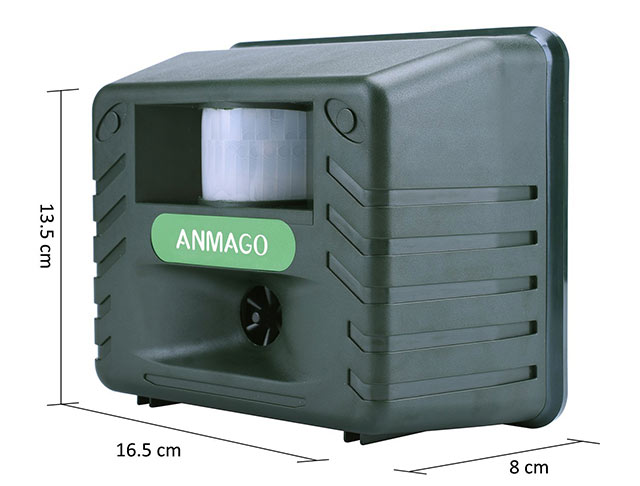 It's waterproof and solar-powered, can be plugged in or run from a battery (not included). It can be attached to a fence or wall and has a good proportion of positive reviews. You can read those reviews here
It's waterproof and solar-powered, can be plugged in or run from a battery (not included). It can be attached to a fence or wall and has a good proportion of positive reviews. You can read those reviews here
Pestzilla Outdoor Animal Repeller
The Pestzilla outdoor animal repeller is a 'box on a spike' type of repeller and claims to be particularly powerful. It incorporates flashing LED lights –
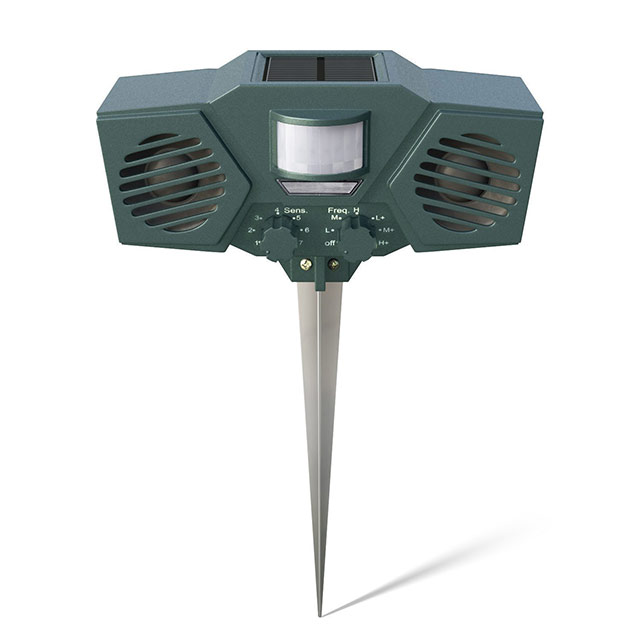 From the White Tail Deer study, we can see that strobe lights did have an effect on deer. Whether they would bother dogs, is a question that remains unanswered, but the majority of Pestzilla's customers seem happy. Check out the reviews here
From the White Tail Deer study, we can see that strobe lights did have an effect on deer. Whether they would bother dogs, is a question that remains unanswered, but the majority of Pestzilla's customers seem happy. Check out the reviews here
BestGreen Animal Repeller
Another repeller that received a high proportion of good reviews was the BestGreen.
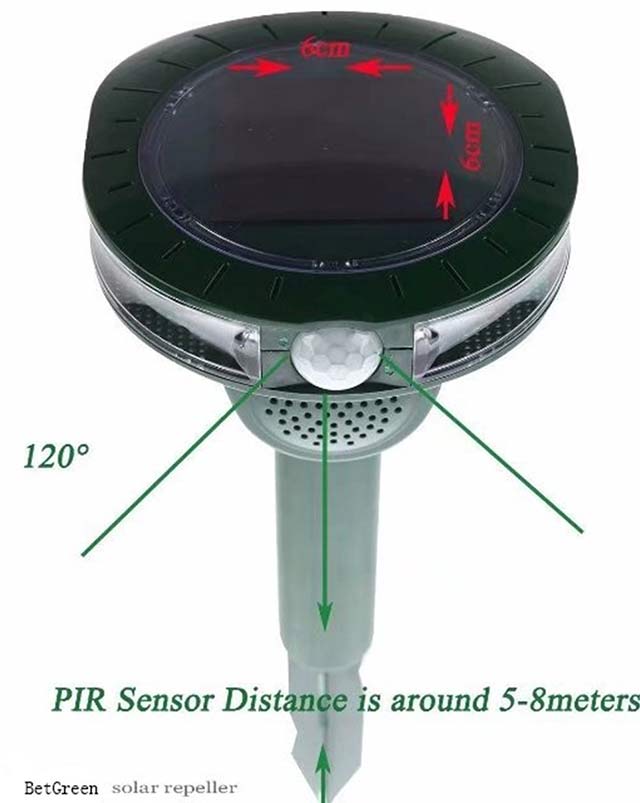 This model also combined LED lights with the ultrasonic noise. Here are the reviews
This model also combined LED lights with the ultrasonic noise. Here are the reviews
Don't scare your dog!
Okay, those are some examples of ultrasonic animal repellers that are claimed by the suppliers to be effective on cats and dogs. But here's the thing to remember. If devices like this work, they probably work by frightening the animal away from the device to keep dogs out of gardens. If you use a device like this in a small area – where your dog cannot easily move away, you are going to have a scared dog on your hands. Possibly a dog that won't go outside at all.
Dog Repellent Sprays – Water
Dog repellers that use water are similar in design to the ultrasonic deterrents in that they are attached to a spike that you push into the ground. They are also triggered by the motion sensors that detect an approaching animal. Instead of the device emitting a sound, it emits a stream of water to keep dogs out of gardens. This means that the device needs to be attached to a water supply. A garden hose is connected to the water inlet, and the trigger operates a valve that releases the stream.
Studies have shown that water jets can be effective at frightening some types of birds away – herons for example – which may appeal if you have a garden pond whose fish population you want to protect. And in the badger study we mentioned above, water jets were also tested and found to have some effect. Though not a very strong one. The devices did reduce food intake at the feeding station but not badger activity overall.
Bear in mind though, that there is less motivation for your dog to approach a flower bed than there is for a wild badger to tuck into a free dinner. So, in theory, it should take less to stop him.
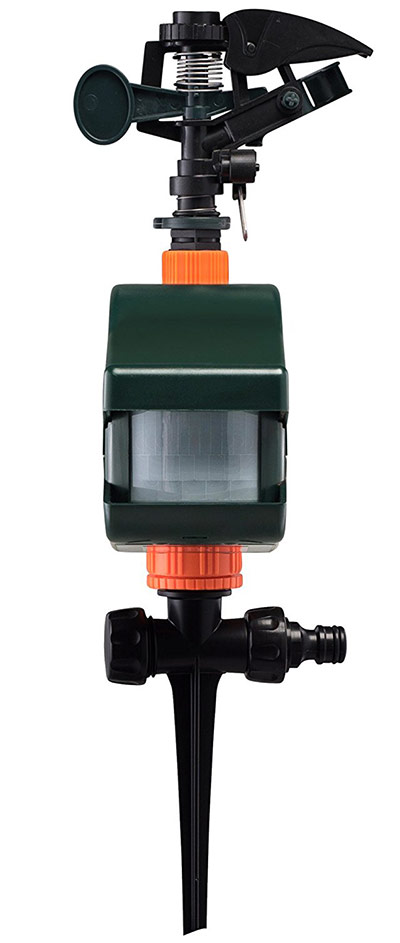 How Water Repellers Work
How Water Repellers Work
This is a fairly typical water spraying animal repeller. As you can see, the water repeller is rather more substantial than the ultrasonic repellers and needs a water supply. Many people are buying and using these for repelling wild animals such as deer or the neighbor's cats. It is debatable how well they might work on water-loving dogs like Labradors. Though, of course, taking a dip in your favorite pond is not the same as being squirted in the face.
Again, the risk with using an aversive like this is unwanted effects. A dog that won't swim on the beach because he has developed a fear of water spray for example. It could happen.
Dog Repellents that use Smell or Odor
There is evidence for the limited effectiveness of certain chemicals or odors as dog repellents to keep dogs out of gardens. But when using these solutions, there are factors to be aware of. Outdoors, any kind of chemical that you apply has the potential to both
- Have some effects on the surrounding area
- Break down and become ineffective soon after application.
Provided that you are aware of these two issues, dog repellent sprays that keep dogs of the flower beds using unpleasant odors may be something you'll want to consider.
Examples of these Repellents
Two such repellents are methyl nonyl ketone and cinnamic aldehyde. In laboratory tests these chemicals reduced damage by dogs and cats to garbage bags by 70-80% and in the field by about half that amount. Most of the products available to the public, however, contain natural ingredients – substances that dogs don't particularly like such as eucalyptus – but the reviews suggest that they are not particularly effective.
Repellent sprays with names like 'liquid fence' and 'critter ridder' sound appealing but may have limited effects to keep dogs out of gardens, partly due to the nature of being outdoors.
If you want to try something like this, you might be better off creating your own home-made concoction. A lot of dogs dislike citrus fruits like lemons. A few lemon slices or citrus peels around your roses might just do the trick. Or you could try placing cotton wool balls soaked in vinegar or ammonia around your precious plants. Mind your fingers and watch closely – some dogs will eat the weirdest things!
Should You Just Wait it Out?
Sometimes, the best option to keep dogs out of garden areas is to wait out this phase. The secret to nice flowerbeds and a fruitful vegetable plot in a yard shared with a Labrador puppy is usually more supervision and/or restriction. Just like we need to move trash bins out of the way (or use puppy proof lids) in the kitchen when leaving a dog alone there, so we also need to take steps to restrict a puppy's opportunities for mischief outdoors. Put up a few barriers, or move things around a bit.
This may seem like a big deal now, but it really is worth it. By the time your dog has passed his second birthday, he will probably have lost much of his passion for landscape design. Hopefully, you will be able to relax and give him free run. Until then, you will find life a lot simpler if you put a temporary fence around your vegetables, move your tubs and planters where he cannot reach them, or fence off part of the yard for your puppy to play in.
When it comes to puppies, it is a good idea to pick your battles carefully. This is one that you may struggle to win.

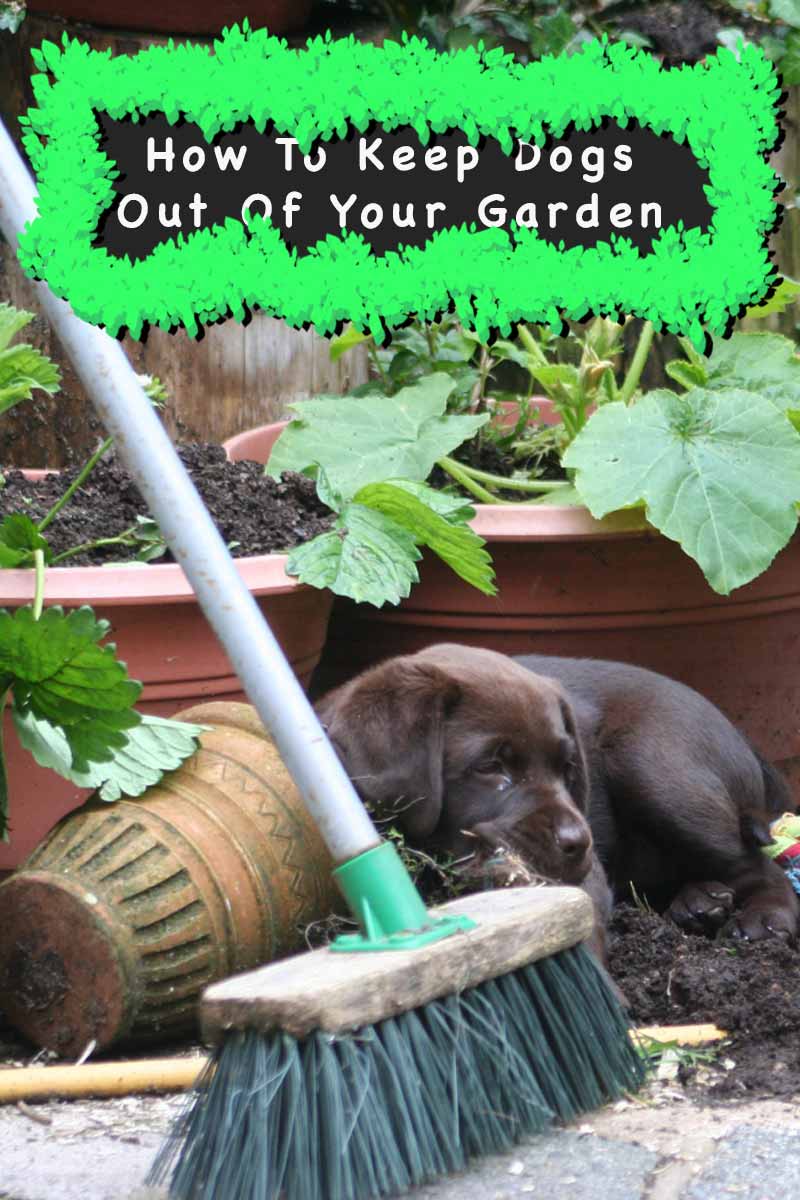 How to Keep Dogs Out of Garden – Summary
How to Keep Dogs Out of Garden – Summary
As you may have discovered, some unsupervised Labrador puppies can cause a great deal of damage if left to their own devices in the yard. There is no foolproof way of controlling what a puppy gets up to when you are not there, and purchasing an ultrasonic or water emitting device for your yard may be something of a gamble.
Remember, there is some dispute as to whether the devices currently on the market for repelling animals using sound or smell actually work. And these devices, while not harmful, do rely on aversives to keep dogs out of garden areas. Most modern trainers believe that using deterrents in animal management should always be a last resort as side effects can be unwanted and unpredictable
One alternative to devices is to train your dog to stay in one part of your yard and away from another part. While training is generally a good idea, when it comes to relaxing and enjoying your garden, it is often better to avoid trouble than to treat it as a training issue. If you decide to give an ultrasonic repeller or spray a try, let us know in the comments how it works!
Readers Also Liked
- How to stop my Labrador from digging
More information on puppies
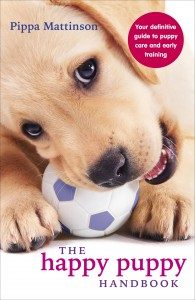 For a complete guide to raising a healthy and happy puppy don't miss The Happy Puppy Handbook.
For a complete guide to raising a healthy and happy puppy don't miss The Happy Puppy Handbook.
The Happy Puppy Handbook covers every aspect of life with a small puppy. The book will help you prepare your home for the new arrival, and get your puppy off to a great start with potty training, socialization and early obedience.
The Happy Puppy Handbook is available worldwide.
This article has been updated for 2019.
References and Further Reading
- Ward A et al. "Deterrent or dinner bell? Alteration of badger activity and feeding at baited plots using ultrasonic and water jet devices" Applied Animal Behavior Science 2008
- Nelson S, Evans A, Bradbury R. "The efficacy of an ultrasonic cat deterrent" Applied Animal Behavior Science 2006
- Edgar J, Appleby R, Jones D "Efficacy of an ultrasonic device as a deterrent to dingoes (Canis lupus dingo): a preliminary investigation" Journal of Ethology 2007
- Bellant J, Seamans T, Tyson L. "Evaluation of Electronic Frightening Devices as White-Tailed Deer Deterrents". University of Nebraska 1998
- Mary Bomford and Peter H. O'Brien Sonic Deterrents in Animal Damage Control: A Review of Device Tests and Effectiveness, Wildlife Society Bulletin (1973-2006)
- Blackshaw J et al. "Aversive responses of dogs to ultrasonic, sonic and flashing light units" Applied Animal Behavior Science 1990
- Lehner P, Krumm R, Cringan A. "Tests for Olfactory Repellents for Coyotes and Dogs" Journal of Wildlife Management 1976

The Labrador Site Founder

Pippa Mattinson is the best selling author of The Happy Puppy Handbook, the Labrador Handbook, Choosing The Perfect Puppy, and Total Recall.
She is also the founder of the Gundog Trust and the Dogsnet Online Training Program
Pippa's online training courses were launched in 2019 and you can find the latest course dates on the Dogsnet website
How To Keep Dogs Out Of Your Garden
Source: https://www.thelabradorsite.com/dog-repellents/
Posted by: rommelcouldic.blogspot.com

0 Response to "How To Keep Dogs Out Of Your Garden"
Post a Comment